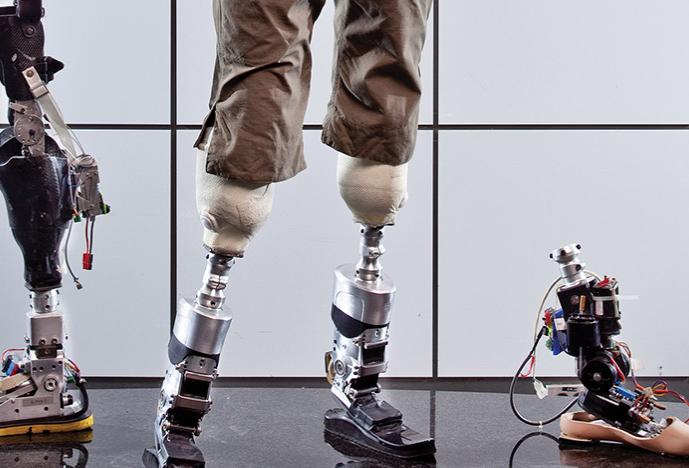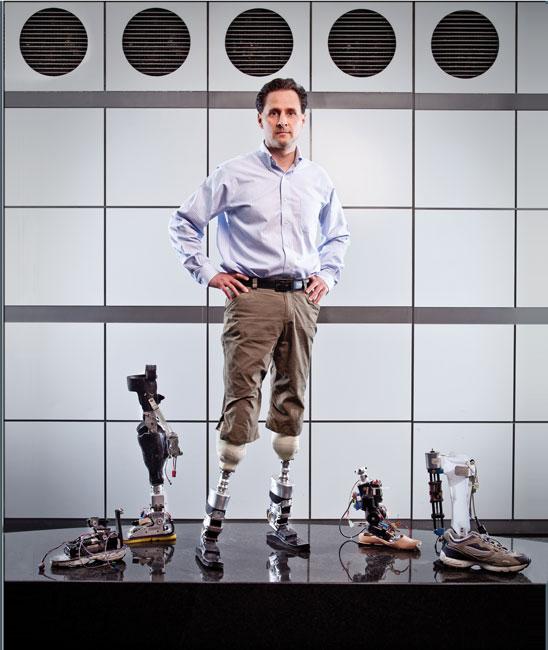
Suppose you met an American who had lost a leg. What would your best guess be as to the reason for that loss?
If you were to say an explosive device in Iraq or Afghanistan, there’s a chance, not quite 1 in 1,000, that you’d be right.
A motorcycle accident or other trauma? Better odds: 7 in 100.
Diabetes? Bingo.
More than 8 in 10 of the 1.7 million Americans who have lost a limb—usually a leg or foot—have done so to dysvascular disease, mainly the result of diabetes. So despite advances in care that have reduced amputations for all other causes, researchers expect the number of Americans affected to double by 2050, lifted almost entirely on the storm tide of obesity and its complications.

But it’s that first group—the 1 in 1,000 who lost a limb in service to their country—that has accelerated the development of high-tech prostheses. In the past decade, defense agencies have funded research that is now yielding a new class of wearable robotics. Used today by a handful of war veterans, these prostheses will soon be available to the other 99.9 percent of those who have lost a limb.
At the vanguard of the smart prosthesis revolution is Hugh Herr, an HMS lecturer on physical medicine and rehabilitation and an MIT associate professor in the Harvard–MIT Division of Health Sciences and Technology. Herr, who underwent a double amputation in 1982, has developed the first ankle-foot prosthesis that, according to key measures, works as well as a natural foot. About a dozen people, including Herr and several veterans, have used the prototype, and this year his company, iWalk, will bring the PowerFoot BiOM (pronounced “bi-ohm”) to the public. Here’s how it works.
To propel a walker forward with each step, modern prostheses use flexible materials, such as carbon fiber, to store energy at impact and then release it. Powered limbs boost that passive propulsion with a motor. The most advanced allow the wearer to adjust power for, say, walking faster or striding uphill. Herr’s engineered foot goes one further, building the adjustment decision-making into the prosthesis itself—just as a natural foot adjusts reflexively to changes in pace or incline.
That control relies on a dozen sensors that each gather about 250 data points per second, measuring the ankle–foot’s force, torque, and absolute positions along three degrees of freedom. Five microprocessors crunch the data, adjusting to terrain in real time. “The device can recognize that a person is on a step, or on a slope between steps,” Herr says. That information keeps the foot moving at a natural gait.
This biomimetic approach required basic research into the structure and function of the human foot. “Believe it or not, the science of how we move, how we walk, is not fully developed,” Herr says. “So we developed biophysical models that walk to help us predict energies and torque.” Neuromuscular modeling yielded insights about the human ankle, Achilles tendon, and calf, including a deeper understanding of the Golgi tendon organ, a proprioceptive, or self-sensing, organ at the intersection of muscle and tendon that helps control reflexive muscle action.
It’s a short step from as good as nature to better, Herr says: “We’re knocking on the door of augmentation.” He points to three challenges to crossing that threshold, each a different example of an extreme interface. The first he calls dynamical: building an interface that behaves like a human limb. This is where the PowerFoot has advanced the most and could go further through improved sensors and pattern recognition. The second he calls mechanical: attaching the limb to a human body. The ideal prosthesis would attach directly to the skeleton, as natural limbs and prosthetic joints do now, but problems of infection arise when prostheses pierce the body. The third he calls electrical: controlling the limb through new types of brain–machine interfaces.
Society has already crossed one other important threshold, says Herr: the psychological. Not long ago, he says, most people who had lost a limb hid their prosthesis from the world. No longer. “If you go to Walter Reed Army Medical Center, soldiers don’t want that beautiful titanium leg covered up,” Herr says. “They wear shorts to the mall.”
Image: Shawn G. Henry